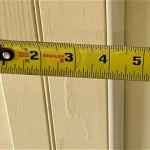How to Fix an Interior Door Frame
An interior door frame, also known as a door jamb, provides the structural support for a door and ensures it hangs correctly. Damage to a door frame can manifest as misaligned doors, difficulty latching, gaps around the door, or visible physical damage. Addressing these issues promptly is essential to maintain the functionality and aesthetics of a home, prevent further damage, and ensure security. This article outlines common problems and detailed methods for repairing an interior door frame.
Identifying Common Door Frame Issues
Before attempting any repair, a thorough assessment of the door frame's condition is crucial. Carefully examine the entire frame, including the head jamb (top), side jambs (sides), and threshold (bottom, if applicable). Common problems include:
Splits and Cracks: These are often caused by impact damage, age, or settling of the house. Small cracks may only require filling and painting, while larger splits may need more extensive repair.
Rot: This is usually found near the bottom of the frame or in areas exposed to moisture. Rot weakens the wood and can spread rapidly if not addressed. The extent of the rot will determine the necessary repair strategy.
Loose Screws or Nails: Over time, fasteners can loosen, causing the frame to shift and the door to become misaligned. These can usually be tightened or replaced with longer, sturdier fasteners.
Warping: This can occur due to changes in humidity or uneven support. Warping can cause the door to bind against the frame or create gaps. Depending on the severity, warping may be difficult to correct, and replacement of the affected section may be necessary.
Impact Damage: Dents, gouges, and scrapes are usually cosmetic but can sometimes affect the structural integrity of the frame. These damages can often be repaired with wood filler and paint.
Repairing Minor Damage: Cracks, Dents, and Holes
For minor damage, the goal is to restore the frame's surface and structural integrity without replacing entire sections. Here’s a step-by-step guide:
1. Preparation: Begin by cleaning the damaged area with a damp cloth to remove any dirt, dust, or loose debris. Allow the area to dry completely. If there are splinters or loose fragments of wood, remove them carefully with a chisel or utility knife.
2. Applying Wood Filler: Select a wood filler that is suitable for the type of wood used in the door frame and can be stained or painted. Follow the manufacturer's instructions for mixing the filler. Using a putty knife, apply the filler to the crack, dent, or hole, pressing it firmly into the void. Overfill slightly to allow for sanding.
3. Sanding: Once the filler has dried completely (refer to the manufacturer's instructions for drying time), sand the area smooth with progressively finer grits of sandpaper. Start with a coarser grit (e.g., 120-grit) to remove excess filler, and then move to a finer grit (e.g., 220-grit) to blend the repaired area seamlessly with the surrounding wood. Feather the edges of the repaired area to avoid sharp transitions.
4. Priming and Painting: Apply a primer to the repaired area to seal the wood filler and provide a uniform surface for painting. Allow the primer to dry completely before applying one or two coats of paint that matches the existing door frame color. Lightly sand between coats of paint for a smoother finish.
Addressing Significant Damage: Rot and Split Frames
When damage is more extensive, such as from rot or a large split, a more involved repair is required. This might involve removing and replacing a section of the door frame.
1. Assessing the Damage: Carefully evaluate the extent of the damage. For rot, probe the surrounding wood with a screwdriver to determine how far the rot has spread. Remove any loose or crumbling wood. For split frames, assess the length and depth of the split and determine if the frame is still structurally sound.
2. Removing the Damaged Section: Using a saw (such as a reciprocating saw or hand saw), carefully cut out the damaged section of the door frame. Make the cuts square and straight to facilitate easy replacement. Ensure the cuts extend beyond the visible damage to reach solid, undamaged wood. Use a chisel to remove any remaining wood or debris from the cut area.
3. Preparing the Replacement Piece: Obtain a piece of wood that matches the dimensions and wood type of the original door frame. Cut the replacement piece to the exact size using accurate measurements. If necessary, rout or shape the replacement piece to match the profile of the original frame. This might involve creating a rabbet for the doorstop or replicating any decorative molding.
4. Installing the Replacement Piece: Apply wood glue to the edges of the replacement piece and the corresponding surfaces of the existing door frame. Position the replacement piece carefully and clamp it securely in place. Ensure the replacement piece is flush with the surrounding frame. Use screws or nails to fasten the replacement piece to the frame, driving them at an angle for added strength. Countersink the screw heads and fill the holes with wood filler.
5. Finishing: Once the glue has dried and the wood filler has hardened, sand the repaired area smooth. Prime and paint the repaired area to match the rest of the door frame. Pay attention to detail to ensure a seamless transition between the old and new wood.
Reinforcing a Weakened Door Frame
Sometimes, a door frame might not have severe damage but feels weak or unstable. Reinforcing the frame can improve its structural integrity without requiring extensive repairs.
1. Tightening Hinges and Strike Plates: Loose hinges and strike plates can cause the door to sag or not latch properly. Tighten the screws on the hinges and strike plate. If the screws are stripped, replace them with longer screws or use wood glue and toothpicks to fill the stripped holes before re-installing the screws.
2. Installing Reinforcement Plates: Metal reinforcement plates can be installed around the strike plate and hinges to provide added support. These plates are typically made of steel and are designed to prevent the door frame from splitting or cracking under stress. Follow the manufacturer's instructions for installation, ensuring the plates are securely fastened to the frame.
3. Adding Longer Screws: Replacing the existing screws in the door frame with longer screws that penetrate deeper into the wall studs can significantly increase the frame's stability. Use screws that are at least 3 inches long and are designed for wood applications. Be careful not to overtighten the screws, as this can strip the wood.
4. Filling Gaps with Shims: If there are gaps between the door frame and the wall studs, use wood shims to fill the gaps. Insert the shims into the gaps and tap them gently with a hammer until they are snug. Trim off any excess shim material with a utility knife. The shims will prevent the door frame from shifting and provide added support.
By carefully identifying the problem, following the appropriate repair techniques, and reinforcing the frame when necessary, it is possible to restore an interior door frame to its original condition and ensure the door functions properly. Regular maintenance, such as tightening screws and addressing minor damage promptly, can help prevent more significant problems from developing in the future.

How To Replace And Repair Broken Door Jamb Kicked In Or Damaged Diy Step By Tutorial Easy Fix

How To Fix A Crooked Door By Adjusting The Frame

How To Repair A Door Frame 5 Ways Fix And Replace Jambs

How To Trim A Door In 10 Minutes

The Foolproof Door Hanging Method

How To Repair Replace Broken Door Jamb Fix Interior And Casing Easy

What Is The Cost To Replace A Door Frame In 2025 Checkatrade

How To Fix An Interior Door The Home Depot

How To Replace Door Trim On A Pre Hung Carpentry

How To Extend Bottom Of Door And Trim After Multiple Layers Flooring Have Been Removed
Related Posts








